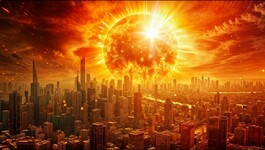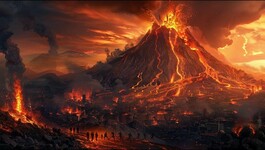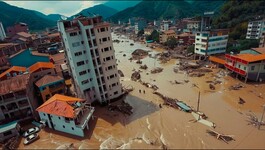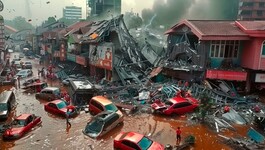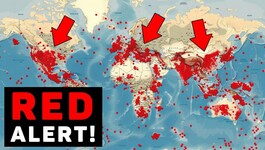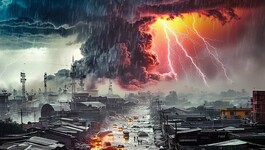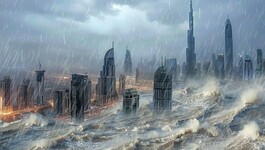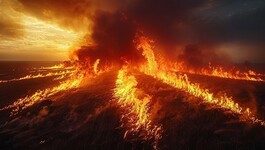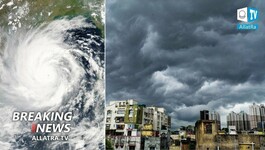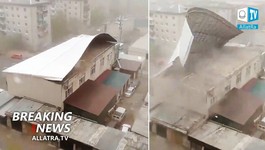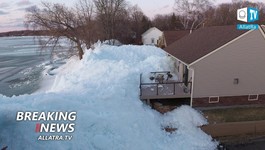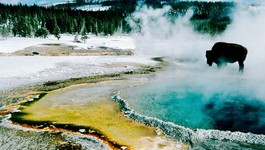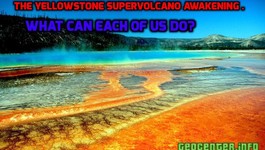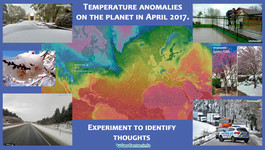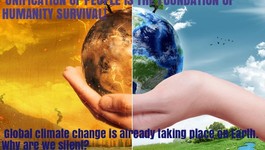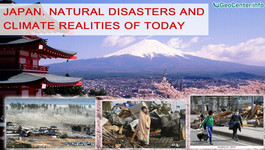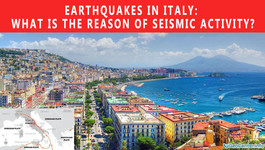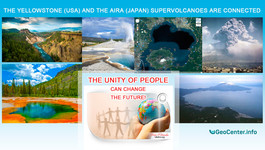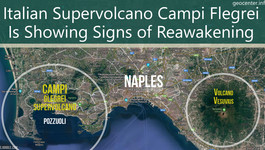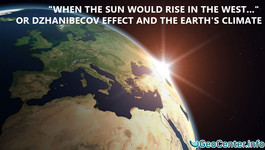Increasing CATACLYSMS: Typhoons, Floods, Snowfalls, Hail. GUATEMALA: Volcán de Fuego erupts again
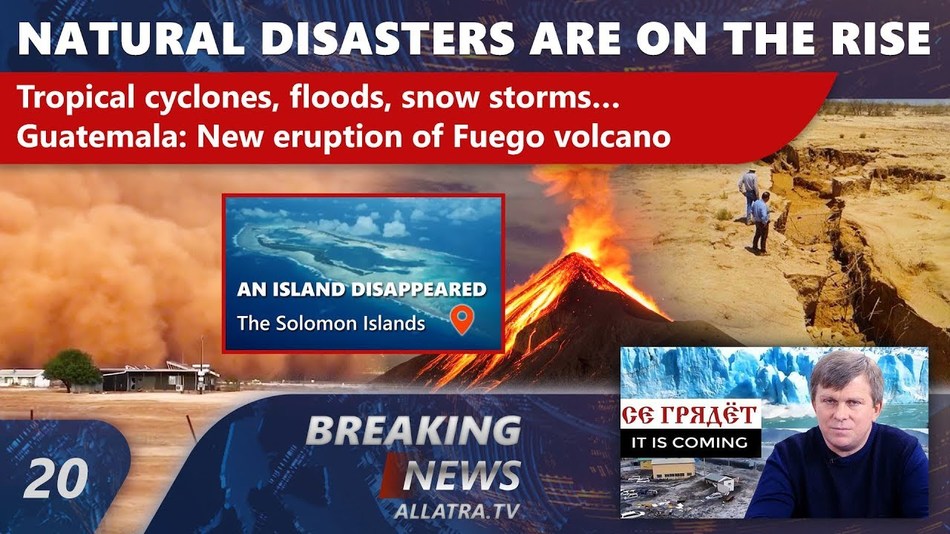
Today, residents from all around the planet are witnessing global climate change.
In the recent time the weather set a lot of new records, causing serious harm to people:
- the most catastrophic wildfires in California
- abnormally high waves in the Canary Islands
- heavy hail in Argentina
- record snowfalls in New York
- earthquakes separating tectonic plates
- islands that has disappeared from the face of the earth
All these events are not the historical past of a thousand years ago! This is what is happening before our eyes.
Australia. In the 16th episode of the Breaking News there was a report about record-breaking drought in Australia. Thus, September was recognized the driest droughted month in the past 119 years.
However, on the 5th of November the situation in the South-East of Australia changed dramatically. On November 6, 2018, the North-West regions of New South Wales were left at the mercy of a powerful sandstorm. Wind speed reached 137 km/h.
And on November 7, in the cities of Kundabung and Rollands Plains, of New South Wales, there fell an anomaly large hail, the size of the hailstones reaching almost 9 cm.
India. On November 16, a destructive cyclone “Gajah” with heavy rains and wind gusts that in some places reaching 90 km / h in some places covered six regions in the India’s state of Tamil
Vietnam. On November 18, Typhoon Toraji brought heavy rainfall, floods and landslides to the Vietnamese resort town of Nha Trang (Khanh Hoa Province). In the region as a whole, the amount of precipitation reached 100 mm, and in some areas - 126 mm.
In Peru from 12th of November powerful rains caused the floods and mudflows, and landslides in three regions of Peru: San Martin, Huanuco and Cusco.
In the previous episode, we talked about the devastating floods in Jordan and prolonged rainfall in Saudi Arabia.
Recently, the floods are increasingly happening in the countries with rather arid climate.
Kuwait. One of the two strong storms, which have passed through the Middle East caused severe flooding in Kuwait. Over 95 millimeters of precipitation fell down in the capital of the country for this period.
The most intensive rainfalls were concentrated in the central-eastern part of Saudi Arabia, in the south of Iraq and in the south-west of Iran.
Argentina. On November 9 a severe gale accompanied by heavy rains and massive hail has hit Argentina. From November 9 to 10, more than 125 mm of precipitation fell on the capital, Buenos Aires, and the surrounding areas. In some areas, more than 250 mm of precipitation fell, which resulted in massive floods.
A landslide occured on the same day in Brazil, in the state of Rio de Janeiro.
Floods in Thailand – an interview with an eyewitness. About the importance of mutual assistance of people.
USA. As the fires continue to devastate California, more and more new examples of the humanity manifestation, mutual help and life saving by the ordinary people are becoming known.
While California is experiencing devastating fires, the US east coast records record snowfalls. Only for one day of November 18, the snow cover reached a height of 16,2 cm. It did not happen here for 136 years. The snowfall appeared to be much stronger than all the meteorological services has forecasted.
In Guatemala on November 19 began to erupt Volcán de Fuego, which in June of this year brought large-scale disasters into the country.
About it’s previous deadly eruption in June this year we reported in our special issue of Climate Breaking News“THE CATASTROPHE. Sudden volcanic eruptions: GUATEMALA and HAWAII.”
On November 19, the highest red alert level of danger had been declared in the region.Temporary shelters for the refugees from the elements are getting prepared.
Mexico. The Popocatepetl volcano in Mexico also shows the signs of increasing activity since November 19. It is not recommended to approach the volcano, especially the crater.
USA, Alaska. On November 21 in Alaska, the Benjamin volcano threw a column of ash to a height of about 5 km. On the same day in Alaska there was an earthquake of magnitude 5.7.
For more information, watch a unique programme on ALLATRA TV: Се грядёт. It is coming
The movie ATLANTIS. THE ELITE IN SEARCH OF IMMORTALITY
___________________
Marina, ALLATRA TV reporter, USA: Hello! This is the Breaking News on ALLATRA TV!
Today, residents from all over the planet are witnessing global climate change.
Lately, nature has set a lot of new records, causing widespread damage:
- the largest forest fires in California
- large hail in Argentina
- record snowfalls in New York
- earthquakes separating tectonic plates
All these events are not the historical past of a thousand years ago! This is what is happening before our eyes.
In the first week of this month, Australia suffered a series of climatic events, with abnormally high precipitation following record drought as well as atypical for this country earthquakes.
AUSTRALIA. Climate Breaking News
The reporter of ALLATRA TV will provide further information about the situation in Australia
Anastasia, ALLATRA TV reporter, Australia: Hello, this is ALLATRA TV reporter from Australia. In the 16th episode of the Breaking News there was a report about record-breaking drought in Australia. Thus, September was recognized as the driest month in the past 119 years.
However, on the 5th of November the situation in the South-East of Australia changed dramatically. There were heavy rains in Victoria State.
Thus, in Melbourne a half of the monthly precipitations norm fell in just 3 hours. Such amount has never fallen in the recent 2 month taken together.
On November 6, 2018, the North-West regions of New South Wales were left at the mercy of a powerful sandstorm.
The localities of White Cliffs, Tibooburra, Packsaddle, and Wilcannia were struck most by the dust storm. The wind speed during the storm reached 137 km/h.
And on November 7, in the cities of Kundabung and Rollands Plains of New South Wales, there fell an anomalously large hail, the size of the hailstones reaching almost 9 cm.
Mark Wilgar from the Australian Bureau of Meteorology described the hailstones, as “extraordinary” and noted that it could be life-threatening.
On November 8, a 5.2 magnitude earthquake occurred in Western Australia. The epicenter of the earthquake tremors was located 63 km away from the city of Kojonup and 279 km away from Perth city.
Citizens of the capital of Western Australia state experienced the underground changes. This earthquake became the second rather powerful one in this region over the last 2 months.
On September 16, there was an earthquake of 5.6 magnitude also 60 km South-West of Kojonup and it was clearly felt in Perth and most of South West region of Australia.
The anomaly of such earthquakes is that they occur at the junction of tectonic plates, while the mainland of Australia is located in its center.
Therefore, all earthquakes occur in the ocean, far from the mainland and barely reach Australia. Minor shocks happen, but they are just recorded by equipment.
___________________
Marina, ALLATRA TV reporter, USA: All over the world, floods continue to be one of the most large-scale and massive disasters. Above average precipitation disrupts the normal rhythm of life in many countries and causes significant damage to the population.
Nadezhda, ALLATRA TV reporter, South Korea: Hello! This is ALLATRA TV reporter from South Korea!
On November 16, a destructive cyclone Gajah with heavy rains and wind gusts, in some places reaching 90 km/h, covered six regions in the India’s state of Tamil Nadu.
On November 18, more than 30 people died from the consequences of this rampant disaster. Information about casualties is being updated daily. Most people died as a result of flooding, destruction of homes, and electric shock.
On November 18, more than 177 thousand people were accommodated in 351 camps. Many houses were blown up by the wind, tens of thousands of trees flattened, and thousands of electric poles were damaged.
Meteorologists warned that the cyclone had shifted to the south of the state of Kerala. Gajah is the second large cyclone to hit the East coast of India in recent weeks.
Also on November 18, Typhoon Toraji brought heavy rainfalls, floods, and landslides to the Vietnamese resort town of Nha Trang (Khanh Hoa Province).
These events were a complete surprise to people. For this reason, there are dead and missing among the local population and tourists. Dozens of cars ended up under the water, many residents evacuated by swimming.
The amount of precipitation reached 100 mm generally across the region, while in some areas up to 126 mm. A lot of damage was caused by rainfall in the city, the infrastructure is damaged.
PERU, KUWAIT. Climate Breaking News
Eddie Paredes, ALLATRA TV reporter, Peru: Hello! This is ALLATRA TV reporter from Peru. In the previous episodes we often reported on the floods affecting the countries.
So, since the 12th of November powerful rains caused floods, mudflows, and landslides in three regions of Peru: San Martin, Huanuco and Cusco.
Altogether, around 300 people were evacuated. Houses were destroyed and damaged.Harm was caused to 50 hectares of agricultural territories. Many areas declared orange threat level.
In the previous episode, we talked about the devastating floods in Jordan and prolonged rainfall in Saudi Arabia. Recently, the floods are happening more and more frequently in the countries with rather arid climate.
One of the two strong storms, which have swept through the Middle East caused severe flooding in Kuwait. Over 95 millimeters of precipitation fell in the capital of the country during one day.
For comparison: over the recent years about 117 mm of precipitation fall here annually. Usually, an average of 18.8 mm falls there during the whole November.
Heavy rains flooded the streets and damaged some buildings.Saudi Arabia and Iran are also partially affected by the floods.
The most intensive rainfalls were concentrated in the central-eastern part of Saudi Arabia, in the south of Iraq and in the South-West of Iran.
ARGENTINA, BRAZIL. Climate Breaking News
Yulia, ALLATRA TV reporter, Ecuador: Hello! This is ALLATRA TV reporter from Ecuador.
In the recent years, news about abnormally large hail in different countries have been appearing even more often.
On November 9, a severe storm accompanied by heavy rain showers and massive hail hit Argentina. From November 9th to 10th, more than 125 mm of precipitation fell in the capital, Buenos Aires, and the surrounding areas.
In some areas, more than 250 mm of precipitation fell, which resulted in massive floods.
Large hail the size of a chicken egg fell in the city of Tilisarao. Bad weather lasted for 10 minutes only; however, it was enough to cause damage to cars and houses. A tornado passed through the city of Chacabuco , in the province of Buenos Aires.
A landslide occured on the same day in Brazil, in the state of Rio de Janeiro, the municipality of Niteroi. People died and houses were destroyed. Rescuers are sifting through debris at the scene of the accident.
According to preliminary data, the landslide was caused by heavy rains.
Marina, ALLATRA TV reporter, USA: First hand reports. What do eyewitness think about the climate? How do they deal with forces of nature? And what conclusions do they draw? Up next is an interview with a witness of flash flooding in Thailand.
Flood in THAILAND and examples of mutual aid
Skype interview with an eyewitness
Lyon: I’m Lyon. I’m from Thailand. I live in Chumphon, a small town.
— Maybe you could share the information that happens there in your place?
Lyon: Yeah. My village got flood last week, flash flood. People around my village can’t move things properly and then they got affected by flood. Some houses got heavy flood, everything is in water. But now it’s ok, the flood water has decreased now.
My house is on a higher place. The villagers, they move to a higher place. But last week my house got flood. Never before. Maybe I think now it’s about the construction, about building about new road, about the water system. Only water can be a big problem, have a big effect to so many people. It’s the first time in my life to see by my eyes.
— Have you noticed before and now this climate change?
Lyon: I think like.. climate change I agree with that. Normally in October, November I can wear a sweater or some sweater coat but now it’s so hot. So many changes about the weather, everyday is different. The weather wins, we can’t predict everything about the weather. Anyway information is so important, maybe help each other, all around the world have this problem.
— How about people? Did you see anything like that where people help each other?
Lyon: Yes, they help each other. Some people have to start like a new life and we have to give them like constant encouragement.
— In this case, like natural disasters or usual life what unites people, what do you think?
Lyon: I think when we live together everything like unique. We’ve got common sense. We have to help each other anyway no matter how flooding. Maybe they don’t have enough money for their children or anything, they‘ve got problems. We have to help anyway. Because we are people in the world. Only one world one life.
— Thank you so much for sharing your experience and information, we wish you good luck in this.
Lyon: It’s my pleasure.
— Thank you, Lyon.
___________________
Marina, ALLATRA TV reporter, USA: It’s true what Lyon said: «So many changes about the weather, everyday is different. The weather wins, we can’t predict everything about the weather. We have to help each other anyway no matter how flooding Because we are people in the world. Only one world one life.»
And these words are confirmed by the actions of eyewitnesses to destructive fires in California.
Narine, ALLATRA TV reporter, USA: Hello! This is ALLATRA TV reporter from California.
As fires continue to devastate California, more and more new examples of acts of humanity, mutual help and life-saving by the ordinary people are becoming known. In the northern parts of the state, a group of people swam across a water pond to get to a remote island, fleeing the fire. A medical brother in the destroyed city of Paradise drove his pickup truck through the fire to save patients from the hospital. Volunteers provided a roof over the heads of the sick and elderly victims of the wildfires. A married couple has sheltered a 93-year-old citizen of Paradise, who managed to leave the city by his car. They offered him to stay with them for as long as he likes. They met while handing out hamburgers to migrants.
About a dozen people escaped the fire by jumping into a pond. When they reached the remote island, the neighbors in a boat picked them up.
USA. Climate disaster series
Evelina, ALLATRA TV reporter, USA: Hello! This is ALLATRA TV reporter from New York.
While California has been experiencing devastating fires, the US East coast witnesses record-breaking snowfalls.
Only in one day, November 18, the depth of the snow cover reached 16.2 cm. Nothing like that happened here for the past 136 years. The snowfall appeared to be much stronger than all the meteorological services had forecasted. Bad weather hampered public transportation. 1,800 flights across the country were canceled due to prohibitive weather conditions. About 20 cm of precipitation fell in St. Louis, Missouri. Due to a snowstorm, traffic on highways was paralyzed in New Jersey.
Many homes were left without electricity.
For example, as an eyewitness living in New York, I can say that in the last 2-3 years it has never been snowing in the middle of November. Since November 13, there was a heavy snowfall with rain. It was way too early.
Marina, ALLATRA TV reporter, USA: In Guatemala, the Fuego volcano began erupting again. It already caused massive disaster in June this summer.
GUATEMALA. Climate Breaking News
Milena, ALLATRA TV reporter, USA: Hello! This is Milena, ALLATRA TV reporter from Atlanta in Georgia.
On November 19th, one of the most active volcanoes started erupting again, the volcano in Guatemala the Volcan de Fuego. You can watch a report on its last death-bringing eruption, which occurred in June this year, in a special release of Breaking News “The Catastrophe. Sudden Volcanic Eruption: Guatemala and Hawaii.”
On November 19th, the highest red level of danger was declared in the region.
Temporary shelters for climate refugees are being prepared. Volcanologists reported that the explosions at an altitude of 3.7 km shocked houses with "constant sounds like the hum of a train."
The red-hot material reached a height of 1 km above the crater, and streams of hot rock and ashes stretched 2.5 km down one of the flanks of the volcano.
The ash plume drifted east towards Guatemala. The greatest danger from the volcano are lahars - mud flows on its slopes, consisting of a mixture of water, volcanic ash and rocks that can bury entire cities. Mass evacuation has been announced in Guatemala - thousands of people rush out of their homes due to the eruption.
The National Disaster Commission reported that about 4 thousand people were evacuated from nearby areas on November 19th in the morning. In total, about 76 thousand inhabitants suffered from the eruption.
The eruption lasted 32 hours, and on November 20th the volcano calmed down. “Activity is decreasing. We can see how the sky darkened by ashes is beginning to clear,” says volcanologist Gustavo Chigna.
_______________
Marina, ALLATRA TV reporter, USA: The planet is changing its appearance again. In the previous episodes, we told you about the disappearing islands. Why does this happen and how many of these losses have been recently registered all over the planet? Why does this process continue and is gaining momentum?
Tatiana, ALLATRA TV reporter, Russian Federation: Hello, this is ALLATRA TV reporter Tatiana.
According to the experts, the average level of the world ocean rises by 3 millimeters per year. But this is the average level, and these processes are faster in some places such as Western Pacific. Due to the combination of wind factors and the peculiarities of underwater currents in this area there is a rise of water by 12 millimeters per year.
Recent studies by American climatologists have shown that the rise in the level of the world's oceans on Earth is slowly accelerating. According to the data obtained from satellite measurements over the past 25 years, the rate of sea level rise is increasing by an average of 0.084 millimetres each year. And the results of this increase can be seen today.
In the previous episodes of Breaking News, it was reported that in September 2018, the researchers noticed the disappearance of a small Island, Esanbe Hanakita Kojima, near the coast of Japan.
And in October the Hawaiian East Island vanished without a trace after hurricane Walaka.
Alarming signals are being received from the Solomon Islands, which have already lost a part of their territory. This is a fairly large archipelago consisting of nearly 1000 Islands, and it is located in the South-Western Pacific Ocean in the Melanesia region.
In 2016, Australian geographers have documented the disappearance of 5 Islands of this archipelago, and in 2017, discovered the disappearance of several Islands in Micronesia, which is also located in the Western Pacific Ocean.
A number of Islands with low elevation have suffered a significant area loss. The ocean absorbs land as its level rises, and what is left is subject to severe water erosion. Loose sedimentary rocks are eroded and carried away into the ocean. That is, the process of land disappearance takes place in two ways at once. These Islands were not so small.
For example, according to local residents, in 1850, a battle between aboriginal tribes took place on the island of Nahlapenlohd. 160 years ago, there was enough space to maneuver, but today this island is gone.
Also, the islands in the East Siberian Sea and the Laptev Sea have disappeared. “The speed of coastal erosion of the ice complex on the headlands is now reaching 20-30 m over the summer. As a result, islands disappear, for example, Semenovsky and Vasilyevsky. In our grandfathers' times, they were still islands, but now they are already “banks” (shallow waters). About 40 km of land has been “eaten” by coastal erosion” over the last 1-2 thousand years.
The example of these islands illustrates that the rise of the world's sea level is not a transcendent event, awaiting the next generations of earthlings. It is already happening. And the consequences of these changes are quite obvious.
Also during their expeditions to the Arctic, Tomsk Polytechnic University scientists and their colleagues found a significant degradation of underwater permafrost. The once-reliable ice block, which impedes the release of huge reserves of gas hydrates, is now worn out. Through these disturbances of underwater permafrost, powerful emissions of methane and bottom sediments reach the atmosphere.
Scientists are trying to determine how much methane is buried in vast areas of the Siberian Arctic shelf. What portion of this giant stock can get into the heights of the atmosphere? What impact can this methane release have on the climate system in the near future?
Marina, ALLATRA TV reporter, USA: Unfortunately, it is not just islands that are disappearing. Other consequences of rapid climate change are irreversible massive losses among flora and fauna. An eyewitness from South America will tell us about the situation in the Amazon forests.
AMAZONIA. CATASTROPHIC LOSS OF FOREST
Interview with an eyewitness, BRAZIL
Sandro, EYEWITNESS FROM BRAZIL: My name is Sandro.
— And you are from?
Sandro: I am from Brazil. I think the whole thing because the droughts, the droughts nowadays we are facing. Because of the carbon dioxides.
And that’s why, I think, the whole planet is becoming warmer than usual.
And we are deforestating the Amazon. It is supposed to absorb this and to cooler the whole world. But as we are producing more things, and we are deforestating on the same way as well, so there is no balance. There is no balance. And I think that’s a big issue.
And, I don’t know, maybe as well, with the warming, you know, not just by the deforestation. But, I think, maybe of the Sun now, because we are facing different time. And all these, all these two factors intervene quite specifically in the whole Amazon.
I think Amazon now is becoming flammable. It is very easy to get fired, because the drought has become more increased. And I think that’s one of the big issues in the Amazon.
Yeah, especially when we have these catastrophes. When all people feel that, you know, like: We are on the same boat. Oh my God, what’s this like? - If you go a big earthquake in an area - everybody’s gonna try to help each other.
So when you have calamities this way we show our real nature. Because normally we want to help people, we want them to be alive and you can see it.
___________________
Marina, ALLATRA TV reporter, USA: The face of our planet is not only changing externally, but internally as well. In 2017, a powerful earthquake in Mexico split the Cocos tectonic plate into two parts. And this was the first event of such a scale registered by scientists. Next our special correspondent will tell us more about this.
MEXICO. Climate disaster series
Vladimir. ALLATRA TV reporter, Russia: This is ALLATRA TV reporter Vladimir Alekseev from Mexico.
The 2017 earthquake tore the tectonic plate in Mexico into two parts. Mexico is used to seismic activity and experiences more than four thousand earthquakes annually, but this time the earthquake was special.
The fact is that in 2017 a very unusual earthquake with a magnitude above 8.2 occurred in Mexico, several dozens of people died. The peculiarity of this earthquake was that it happened not at the junction of two tectonic plates, which hadn’t been observed by the scientists before.
Typically, earthquakes occur on the border of tectonic plates. But in September 2017 in a place called Tehuantepec, an earthquake occured in fact off the border, which surprised scientists, because this have never been observed before.
«NATIONAL GEOSCIENCE» found out that the tectonic plate Cocos began to sink into the ground for some strange reasons. As a result of the movement and immersion of the plate, there formed a crack that measures 196 kilometers (121,79 miles) long, 96 km (59,65 miles) wide, and about 30 km (18,64 miles) deep.
This crack split the tectonic plate into two. Scientists often observe small cracks on plateaus as well as cracks along the tectonic plates’ boundaries, but such an earthquake which divided the plate into two not on the border, but straight across is being observed for the first time.
This change in Mexico, as well as other events that are taking place on the planet, show that humanity has seriously faced the issue of global climate change. The events happening on the planet are being recorded by scientists for the first time, and some of them even can’t be explained. In the light of this it is the high time for the humanity to think about uniting before the upcoming events, as it is written in the report of the international group of ALLATRA SCIENCE researchers.
Marina, ALLATRA TV reporter, USA: The world is changing its shape right in front of our eyes.
It is difficult to ignore what’s happening, since we are all eyewitnesses to global climate change. However, the cause of that change is a lot deeper than it seems. How ready are we to act and support each other in difficult situations? After all, only together it is possible to create a strategy of mutual assistance by joining efforts to cope with any difficulties.

